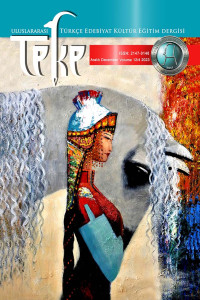Öz
Roma’nın kuruluşuyla ilgili bilinen en önemli örnek olan Romulus ve Remus’un dişi bir kurt tarafından emzirilerek hayatta tutulması hikâyesi, “Lupa Romana” olarak adlandırılmaktadır. Roma mozaik sanatı örneklerinde özellikle sivil mimaride karşımıza çıkan tasvirin bir propaganda unsuru olarak kullanıldığı anlaşılmaktadır. Ayrıca Roma, Etrüsk ve Türk mitolojisi söylencelerinden hareketle dişi kurt tasvirinin ilk olarak Orta Asya’da kullanıldığı tespit edilmiştir. Kurt imgesinin dünya mitolojilerindeki kullanımı da incelenerek arketip belirlenirken tek bir kültüre odaklanmanın önüne geçilmiştir. Sonuç olarak farklı kültürlerde işlenen kutsal kurdun kültürleri etkilediği noktalar analiz edilmiş ve Orta Asya’daki tasvirler arketip olarak kabul edilerek Roma kültürüyle birlikte diğer topluluklara da yayıldığı anlaşılmıştır.
Anahtar Kelimeler
Kaynakça
- Altun, Z. (2019). Türk kültüründe “kurt kavramı” üzerine bir inceleme. 21. Yüzyılda Eğitim ve Toplum Dergisi, 22, 91-108.
- Alyılmaz, C. (2016). Gobustan’ın gizemi: Kıpçaklara giden yol. Ankara: Bitlis Eren Üniversitesi Yayınları.
- Atlan, S. (2014). Roma Tarihi’nin ana hatları: I. kısım Cumhuriyet Devri. Ankara: Türk Tarih Kurumu.
- Blazquez, J. M. (1981). Mosaicos Romanos de Cordoba, Jaen y Malaga. Madrid.
- Çoruhlu, Y. (2016). Kurttan türeme efsaneleri ile ilgili Avrasya tasvirleri üzerine düşünceler. XX. Uluslararası Ortaçağ ve Türk Dönemi Kazıları ve Sanat Tarihi Araştırmaları Sempozyumu Bildirileri, 988-1004.
- Çoruhlu, Y. (2021). Türk mitolojisinin kısa tarihi. İstanbul: Alfa Araştırma.
- Demircioğlu, H. (2011). Roma tarihi: I. cilt Cumhuriyet. Ankara: Türk Tarih Kurumu.
- Erzen, A. (1978). Bibliyografya: Prof. Dr. Andreas Alföldi, die Struktur des voretrüskischen Römerstaates, Belleten, XLII – 166, 301-303.
- Estin, C. ve Laporte, H. (2008). Yunan ve Roma mitolojisi. Ankara: TÜBİTAK.
- Green, B. (2010). Christianity in Rome in the first three centuries. New York: T&T Clark International.
- Grimal, P. (2012). Mitoloji sözlüğü: Yunan ve Roma. İstanbul: Kabalcı.
- İmanov, A. (2021). Mitoloji ve modern dünya halklarının kültüründeki “Kurt” imgesinin rolü ve işlevi ile dünya sinema filmlerindeki kurt imgesinin karşılaştırılması. Yayımlanmamış yüksek lisans tezi, İstanbul: İstanbul Üniversitesi Sosyal Bilimler Enstitüsü.
- İplikçioğlu, B. (2007). Hellen ve Roma tarihinin anahatları. İstanbul: Arkeoloji ve Sanat.
- Kolot, B. (2021). Türk boylarının destanlarında kurt. Yayımlanmamış doktora tezi, Konya: Necmettin Erbakan Üniversitesi Sosyal Bilimler Enstitüsü.
- Ögel, B. (2014). Türk mitolojisi: I. cilt. Ankara: Türk Tarih Kurumu.
- Rissanen, M. (2014). The Lupa Romana in the Roman Provinces. Acta Archaeologica Academiae Scientiarum Hungaricae, 65, 335-360.
- Rosenberg, D. (2003). Dünya mitolojisi:Büyük destan ve söylenceler antolojisi. Ankara: İmge Kitabevi Yayınları.
- Şahin, D. (2017). Roma mitolojisi. İstanbul: Uludağ Üniversitesi Yayınları.
- Tunç, Z. ve Akbulut, Y. (2016). Eski Türk devletlerinin destanlarına göre kurttan ve ağaçtan türeme. Marmara Türkiyat Araştırmaları Dergisi, III-1, 83-91.
- https://www.ostia-antica.org/regio5/2/2-8.htm (27.05.2023)
- https://www.waymarking.com/waymarks/wm5CEG_Stazione_Ostiense_Roma_Italy (27.05.2023)
- https://himsnewspaper.org/2020/08/syrian-mosaic-surprise/ (27.05.2023)
REPRESENTATION OF THE MYTH OF THE FOUNDATION OF ROME ON MOSAIC ART AND THE ARCHETYPE OF THE SHE-WOLF
Öz
The story of Romulus and Remus being kept alive by being suckled by a she-wolf, the most important known example of the founding of Rome, is called "Lupa Romana". It is understood that the depiction, which we encounter in Roman mosaic art examples, especially in civil architecture, was used as an element of propaganda. In addition, it has been determined that the depiction of the she-wolf was first used in Central Asia based on the myths of Roman, Etruscan and Turkish mythology. The use of the wolf image in world mythologies was also examined to avoid focusing on a single culture when determining the archetype. As a result, the points where the sacred wolf in different cultures influenced the cultures were analyzed and it was understood that the depictions in Central Asia were accepted as archetypes and spread to other communities with the Roman culture.
Anahtar Kelimeler
Kaynakça
- Altun, Z. (2019). Türk kültüründe “kurt kavramı” üzerine bir inceleme. 21. Yüzyılda Eğitim ve Toplum Dergisi, 22, 91-108.
- Alyılmaz, C. (2016). Gobustan’ın gizemi: Kıpçaklara giden yol. Ankara: Bitlis Eren Üniversitesi Yayınları.
- Atlan, S. (2014). Roma Tarihi’nin ana hatları: I. kısım Cumhuriyet Devri. Ankara: Türk Tarih Kurumu.
- Blazquez, J. M. (1981). Mosaicos Romanos de Cordoba, Jaen y Malaga. Madrid.
- Çoruhlu, Y. (2016). Kurttan türeme efsaneleri ile ilgili Avrasya tasvirleri üzerine düşünceler. XX. Uluslararası Ortaçağ ve Türk Dönemi Kazıları ve Sanat Tarihi Araştırmaları Sempozyumu Bildirileri, 988-1004.
- Çoruhlu, Y. (2021). Türk mitolojisinin kısa tarihi. İstanbul: Alfa Araştırma.
- Demircioğlu, H. (2011). Roma tarihi: I. cilt Cumhuriyet. Ankara: Türk Tarih Kurumu.
- Erzen, A. (1978). Bibliyografya: Prof. Dr. Andreas Alföldi, die Struktur des voretrüskischen Römerstaates, Belleten, XLII – 166, 301-303.
- Estin, C. ve Laporte, H. (2008). Yunan ve Roma mitolojisi. Ankara: TÜBİTAK.
- Green, B. (2010). Christianity in Rome in the first three centuries. New York: T&T Clark International.
- Grimal, P. (2012). Mitoloji sözlüğü: Yunan ve Roma. İstanbul: Kabalcı.
- İmanov, A. (2021). Mitoloji ve modern dünya halklarının kültüründeki “Kurt” imgesinin rolü ve işlevi ile dünya sinema filmlerindeki kurt imgesinin karşılaştırılması. Yayımlanmamış yüksek lisans tezi, İstanbul: İstanbul Üniversitesi Sosyal Bilimler Enstitüsü.
- İplikçioğlu, B. (2007). Hellen ve Roma tarihinin anahatları. İstanbul: Arkeoloji ve Sanat.
- Kolot, B. (2021). Türk boylarının destanlarında kurt. Yayımlanmamış doktora tezi, Konya: Necmettin Erbakan Üniversitesi Sosyal Bilimler Enstitüsü.
- Ögel, B. (2014). Türk mitolojisi: I. cilt. Ankara: Türk Tarih Kurumu.
- Rissanen, M. (2014). The Lupa Romana in the Roman Provinces. Acta Archaeologica Academiae Scientiarum Hungaricae, 65, 335-360.
- Rosenberg, D. (2003). Dünya mitolojisi:Büyük destan ve söylenceler antolojisi. Ankara: İmge Kitabevi Yayınları.
- Şahin, D. (2017). Roma mitolojisi. İstanbul: Uludağ Üniversitesi Yayınları.
- Tunç, Z. ve Akbulut, Y. (2016). Eski Türk devletlerinin destanlarına göre kurttan ve ağaçtan türeme. Marmara Türkiyat Araştırmaları Dergisi, III-1, 83-91.
- https://www.ostia-antica.org/regio5/2/2-8.htm (27.05.2023)
- https://www.waymarking.com/waymarks/wm5CEG_Stazione_Ostiense_Roma_Italy (27.05.2023)
- https://himsnewspaper.org/2020/08/syrian-mosaic-surprise/ (27.05.2023)
Ayrıntılar
| Birincil Dil | Türkçe |
|---|---|
| Konular | Arkeoloji (Diğer) |
| Bölüm | Makaleler |
| Yazarlar | |
| Yayımlanma Tarihi | 15 Aralık 2023 |
| Gönderilme Tarihi | 6 Temmuz 2023 |
| Kabul Tarihi | 8 Ağustos 2023 |
| Yayımlandığı Sayı | Yıl 2023 Cilt: 12 Sayı: 4 |


